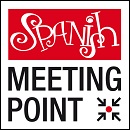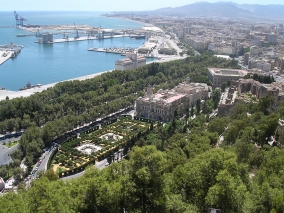Spanish schools and accommodation to study Spanish in Spain
Recent posts
Last schools
introduced
introduced
1 Accommodation

1 Spanish schools

Learning Spanish in Malaga. The tourist guide to study your Spanish course.
General Information. 570,000 inhabitants. 544 kilometres south of Madrid. Malaga is situated on the Mediterranean coast, just over 100 kilometres to the east of the Strait of Gibraltar, and belongs to the Autonomous Community of Andalusia. It is the sixth largest city in Spain and the second largest in Andalusia. Malaga is the most important city on the Costa del Sol, with 15 beaches spread along its coastline. Founded in the 8th century BC, it was named a confederate city of Rome, and was four times the capital of the Al-Andalus kingdom of Malaga. The city's university dates from 1972 and caters for nearly 40,000 students. Malaga is a very attractive place to study Spanish with many language schools offering a wide range of courses.
Surrounding Areas. The main cities of Andalusia are located within easy reach of Malaga: Seville (209 kilometres), Córdoba (160 kilometres), Granada (134 kilometres) and Cádiz (253 kilometres). All along the coast and in the sierra to the north there are numerous towns and villages which are well worth a visit, including the ever-popular Mijas (40 kilometres), Ronda (102 kilometres) and Casabermeja (24 kilometres), the latter two forming part of the ‘Route of the White Hill Towns'. Nerja (57 kilometres to the east) is a seaside resort with excellent beaches and sandy coves such as Cala Maro and Cala Pino, and the Chillar River and the picturesque hilltop village of Frigiliana are both nearby. The Sierra de Tejeda Nature Reserve is 50 kilometres away in the same direction, and three major coastal resorts lie to the west: Torremolinos (17 kilometres), Benalmádena (24 kilometres) and Marbella (60 kilometres), the latter renowned for attracting tourists from all over the world.
Main Sights. La Alcazaba, a military fortification built on the walls of a Roman fortress in the 11th century and connected to Mount Gibralfaro, offers magnificent views of Malaga and the sea thanks to its hilltop location. The Cathedral, which is popularly known as La Manquita (the one-armed lady) as one of the two towers is missing, began to be built in 1528 on the site of a former mosque. Malaga's bullring dates from 1874 and can hold up to 15,000 people. The house where Picasso was born is just one of many places of interest in a city that boasts countless museums, palaces, gardens and churches, including the 18th century Marquis of Valdeflores Palace, the Episcopal Palace, which stands next to the cathedral and represents the typical Malaga style of the 17th century, and the ‘Customs Palace' (Palacio de la Aduana), currently occupied by the Regional Government. The lively atmosphere of the historic city centre is best experienced by taking a stroll through its narrow, winding streets, while a car ride is an ideal way to discover the charms of the city's coastline.
Culture. Malaga Film Festival (April), Malaga Summer Festival (July) with concerts spanning a variety of styles, such as rock, flamenco, fado... The most important museums are the Picasso Museum, the Centre for Contemporary Art and the National Museum of Airports and Air Transport. The Cervantes Theatre, which hosts the famous Film Festival, shows a wide range of productions throughout the year.
Beaches. Malaga is on the Costa del Sol and has many different types of beaches: dark sand with pebbles, golden sand, coves... There are beaches in the city centre, beaches for nudists, and others which are ideal for surfing, such as Benalmádena. They can be enjoyed nearly all year round, thanks to the mild climate and very pleasant temperatures. The beaches are a major attraction for the many students who decide to study Spanish in Malaga.
Gastronomy. Tapeo, the quintessentially Spanish custom of eating a small snack with each drink as one hops from bar to bar, is particularly popular in Malaga, but the city also offers a range of gastronomic styles to cater for all tastes, including traditional local specialities such as pescaito frito (portions of deep-fried fish), as well as international and creative cuisine. The local desserts, cakes and pastries also have a very good reputation. Many good bars and restaurants can be found at seafront locations just a few kilometres from the city centre, such as Carihuela beach between Torremolinos and Benalmádena, while visitors to Ronda and Mijas can enjoy the typical dishes of the sierra.
Sports. The city's first division football team, Malaga Football Club, play at La Rosaleda stadium. West of the city centre, the 22,000 m² José María Martín Carpena Sports Arena (Palacio de Deportes) is home to the Malaga-Unicaja Basketball Club, which competes in the national ACB league, while the nearby Malaga Aquatic Centre, the third most important in Spain, offers superb facilities for skydiving, sailing, windsurfing, diving and other aquatic sports. The Costa del Sol also boasts the largest selection of golf courses in Spain.
Fiestas. Malaga has three fiestas par excellence: Holy Week, which was declared an Event of International Tourist Interest in 1965; the Fair (third week of August), when tens of thousands of locals deck themselves out in traditional costumes, fill the streets and flock to the fairground to eat pescaito frito, drink sherry, dance and be merry; and the Carnival (February), which differs from those celebrated elsewhere.
Transport. Thanks to its geographical location, Malaga has an excellent rail, air, sea and road transport network. The city is very well connected and offers many facilities for travelling, including a high-speed rail link with Madrid. As you can see, it is easy to get from Malaga to other Spanish cities. There is also a city sightseeing bus tour with 14 stops.
Nightlife. Students who decide to study Spanish in Malaga will discover a very active nightlife. If you take a look around the city centre after the sun goes down, you will find people enjoying the pleasant evening temperatures as they stroll the streets or go from bar to bar for drinks and tapas; the locals usually meet in the bars on Plaza de la Merced or in the streets adjoining Calle Larios, before heading off to the pubs and discotheques dotted around the city, or to the beach bars which open all day and most of the night, where you can find people dancing on the sand, music, drinks... There are also plenty of nighttime entertainment options outside Malaga, Los Álamos and the Marina at Benalmádena being among the most popular.
Useful phone numbers.
Unitaxi......................: 952320000
Tele Taxi..................: 951138033
Ave Taxi....................: 951110653
Ayuda en carretera : 900123505
Bomberos................: 080
Cruz Roja.................: 902222292
Emergencias...........: 112
Policía Nacional......: 091
Renfe (trenes).........: 902240202
Turismo....................: 952214120
Entertainment Calendar.
Cinema
Concerts
Theatre and other shows
_________________________________________________________________
SHOPS AND ESTABLISHMENTS IN MÁLAGA.
To advertise here visit this Link.
_________________________________________________________________
Surrounding Areas. The main cities of Andalusia are located within easy reach of Malaga: Seville (209 kilometres), Córdoba (160 kilometres), Granada (134 kilometres) and Cádiz (253 kilometres). All along the coast and in the sierra to the north there are numerous towns and villages which are well worth a visit, including the ever-popular Mijas (40 kilometres), Ronda (102 kilometres) and Casabermeja (24 kilometres), the latter two forming part of the ‘Route of the White Hill Towns'. Nerja (57 kilometres to the east) is a seaside resort with excellent beaches and sandy coves such as Cala Maro and Cala Pino, and the Chillar River and the picturesque hilltop village of Frigiliana are both nearby. The Sierra de Tejeda Nature Reserve is 50 kilometres away in the same direction, and three major coastal resorts lie to the west: Torremolinos (17 kilometres), Benalmádena (24 kilometres) and Marbella (60 kilometres), the latter renowned for attracting tourists from all over the world.
Main Sights. La Alcazaba, a military fortification built on the walls of a Roman fortress in the 11th century and connected to Mount Gibralfaro, offers magnificent views of Malaga and the sea thanks to its hilltop location. The Cathedral, which is popularly known as La Manquita (the one-armed lady) as one of the two towers is missing, began to be built in 1528 on the site of a former mosque. Malaga's bullring dates from 1874 and can hold up to 15,000 people. The house where Picasso was born is just one of many places of interest in a city that boasts countless museums, palaces, gardens and churches, including the 18th century Marquis of Valdeflores Palace, the Episcopal Palace, which stands next to the cathedral and represents the typical Malaga style of the 17th century, and the ‘Customs Palace' (Palacio de la Aduana), currently occupied by the Regional Government. The lively atmosphere of the historic city centre is best experienced by taking a stroll through its narrow, winding streets, while a car ride is an ideal way to discover the charms of the city's coastline.
Culture. Malaga Film Festival (April), Malaga Summer Festival (July) with concerts spanning a variety of styles, such as rock, flamenco, fado... The most important museums are the Picasso Museum, the Centre for Contemporary Art and the National Museum of Airports and Air Transport. The Cervantes Theatre, which hosts the famous Film Festival, shows a wide range of productions throughout the year.
Beaches. Malaga is on the Costa del Sol and has many different types of beaches: dark sand with pebbles, golden sand, coves... There are beaches in the city centre, beaches for nudists, and others which are ideal for surfing, such as Benalmádena. They can be enjoyed nearly all year round, thanks to the mild climate and very pleasant temperatures. The beaches are a major attraction for the many students who decide to study Spanish in Malaga.
Gastronomy. Tapeo, the quintessentially Spanish custom of eating a small snack with each drink as one hops from bar to bar, is particularly popular in Malaga, but the city also offers a range of gastronomic styles to cater for all tastes, including traditional local specialities such as pescaito frito (portions of deep-fried fish), as well as international and creative cuisine. The local desserts, cakes and pastries also have a very good reputation. Many good bars and restaurants can be found at seafront locations just a few kilometres from the city centre, such as Carihuela beach between Torremolinos and Benalmádena, while visitors to Ronda and Mijas can enjoy the typical dishes of the sierra.
Sports. The city's first division football team, Malaga Football Club, play at La Rosaleda stadium. West of the city centre, the 22,000 m² José María Martín Carpena Sports Arena (Palacio de Deportes) is home to the Malaga-Unicaja Basketball Club, which competes in the national ACB league, while the nearby Malaga Aquatic Centre, the third most important in Spain, offers superb facilities for skydiving, sailing, windsurfing, diving and other aquatic sports. The Costa del Sol also boasts the largest selection of golf courses in Spain.
Fiestas. Malaga has three fiestas par excellence: Holy Week, which was declared an Event of International Tourist Interest in 1965; the Fair (third week of August), when tens of thousands of locals deck themselves out in traditional costumes, fill the streets and flock to the fairground to eat pescaito frito, drink sherry, dance and be merry; and the Carnival (February), which differs from those celebrated elsewhere.
Transport. Thanks to its geographical location, Malaga has an excellent rail, air, sea and road transport network. The city is very well connected and offers many facilities for travelling, including a high-speed rail link with Madrid. As you can see, it is easy to get from Malaga to other Spanish cities. There is also a city sightseeing bus tour with 14 stops.
Nightlife. Students who decide to study Spanish in Malaga will discover a very active nightlife. If you take a look around the city centre after the sun goes down, you will find people enjoying the pleasant evening temperatures as they stroll the streets or go from bar to bar for drinks and tapas; the locals usually meet in the bars on Plaza de la Merced or in the streets adjoining Calle Larios, before heading off to the pubs and discotheques dotted around the city, or to the beach bars which open all day and most of the night, where you can find people dancing on the sand, music, drinks... There are also plenty of nighttime entertainment options outside Malaga, Los Álamos and the Marina at Benalmádena being among the most popular.
Useful phone numbers.
Unitaxi......................: 952320000
Tele Taxi..................: 951138033
Ave Taxi....................: 951110653
Ayuda en carretera : 900123505
Bomberos................: 080
Cruz Roja.................: 902222292
Emergencias...........: 112
Policía Nacional......: 091
Renfe (trenes).........: 902240202
Turismo....................: 952214120
Entertainment Calendar.
Cinema
Concerts
Theatre and other shows
_________________________________________________________________
SHOPS AND ESTABLISHMENTS IN MÁLAGA.
To advertise here visit this Link.
_________________________________________________________________
© TEXT: SPANISH IN TOUR.
VIDEO: Patronato de Turismo de Málaga
VIDEO: Patronato de Turismo de Málaga
























